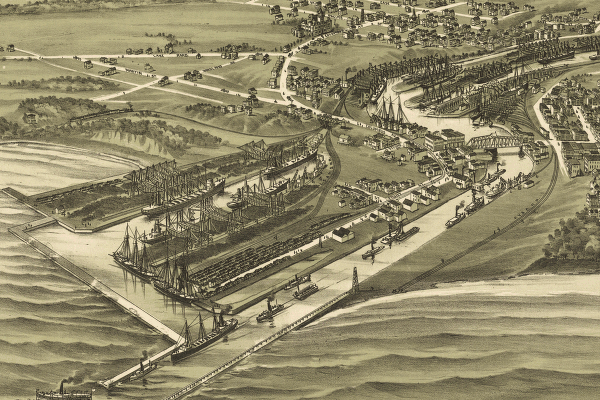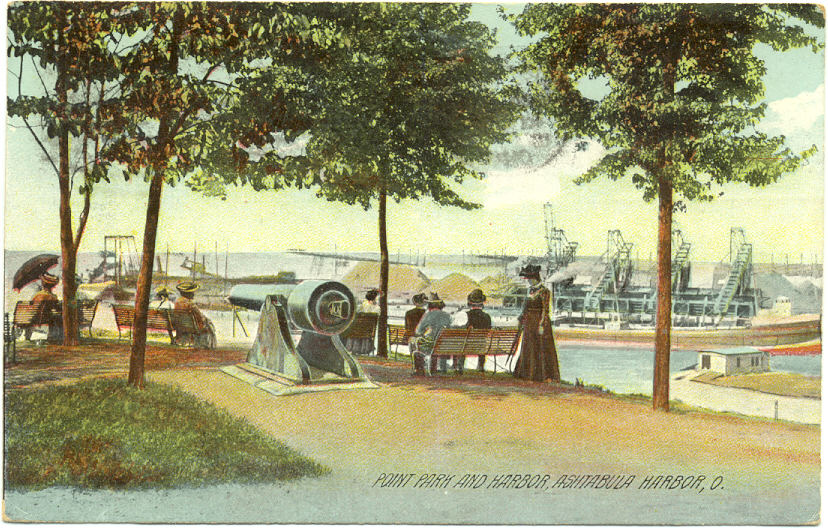|
This is how the Harbor looked when Edward came to America around
1897. See the old Hoists? Men shoveled ore into tubs that were carried along the framework from the ships to the rail yard.
Click on the photos for larger views of the Harbor in 1896.


This second photo shows more of the town. Can you find the Ollila Home and Grocery Store on Oak Street?
The link below will take you to a bird's eye view of Ashtabula Harbor where you can zoom into any building.
Library of Congress Interactive Panoramas
Point Park Then and Now

To Miss Maud Turner, Box 106, Ada, Ohio, 9-Mar-07
We landed here all right, but left the trunk in Ada.
Earl sends
his best regards. G. Q.
1907. When this postcard was mailed on March 9, Hilma and Edward were 21 and 24 years old. First son, Rufus was 2
and they were expecting Viola on June 7.
2002. Tucked into a back corner, a visitor would find the Operator's cab
and bucket of a great Hulett, controls still working. Is it still there?
Yes. On the day of Lil's funeral, Dave's brother, Frenchy, took me to the Harbor to show me around.
He remembers all of it.
Town Life
Bridge Street
Downtown
Ashtabula Bridges
Pic of
Old Ollila Store (Chapman's)
Passages from Henry Howe's Historical Collections of Ohio, 1888.
Page 273
Passages from Henry Howe's Historical Collections of Ohio, 1888.
Page 273
Ashtabula, on Ashtabula river, and line of four railroads, is the principal town of a large agricultural
and dairying district. It has about 7,000 inhabitants and is growing rapidly, owing to the development of its natural advantages
as a point of shipment of coal to the lake cities of the west, and ore from the Lake Superior mining districts. Ashtabula
has 4 newspapers; Ashtabula Telegraph, Republican, James REED, editor; News, Independent, E. J. GRIFFIN, editor; Standard,
Democratic, J. SHERMAN, editor; Record,daily, Republican, F. V. JOHNSON, editor; also 2 Finn, semi-weeklies. 8 churches-1
Methodist, 1 Baptist, 1 Presbyterian, 2 Congregational, 2 Episcopal and 1 Catholic. Banks: Ashtabula National, P.F.
GOOD, president; J.SUM. Blyth, cashier; Farmer's National, H.E. PARSONS, president; A. F. HUBBARD, cashier.
Manufactures and Employees – Ashtabula Tool Co., agricultural implements, 96 hands; L.M.
Crossby & Son, Fanning Mills, 15; Phoenix Iron Works Co., machinery and castings, 18; Ashtabula Hide & Leather Co.,32;
Ashtabula Carriage Bow Co., London Rubber Co., rubber clothing, 74.- State Report 1886. Population in 1880,4,445; School
census 1886, 1,172. Supt., I.M.Clemens.
The principal feature of Ashtabula is its harbor, which promises to lead all the lake ports in the amount of iron ore received.
From thirty to fifty vessels arrive weekly with cargoes of ore, while the shipments of coal nearly equal those of Cleveland
or Erie. From 700 to 1,000 men are constantly employed on the docks, a large proportion of them being Fins and Swedes
– a thrifty people and good citizens, most of them owning their homes. The harbor is three miles from the main
town, but it is a part of the same corporation; it is connected with it by a street railway. The rapid development and
growth of Ashtabula in the past twelve years has been owing to the enterprise of the citizens, with the aid of the National
government in developing its natural harbor. When the work now in progress is completed it will have a channel with
a uniform depth of eighteen feet.
Along the banks of the Ashtabula river are thousands of feet of docks, from which twenty to forty vessels are constantly
loading or unloading their cargoes. The iron ore is shipped to the manufacturing regions of Youngstown, Pittsburg and
farther east, while thousands of tons of coal are conveyed here by the railroads from the great coal field of Ohio and Pennsylvania
and shipped to Chicago, Duluth and other lake cities in the west.
Ashtabula harbor is supplied with the most improved machinery for handling coal and ore of any of the lake ports, and it
is not unusual for propellers carrying 2,400 tons of iron ore to be unloaded inside of twelve hours.
In 1872 this district about the river and harbor contained less than 200 inhabitants, two or three struggling stores, and
one or two old decaying warehouses, relics of former industry. Now it has more than 2,000 inhabitants, is a flourishing
community and a scene of ceaseless activity night and day.
Page 274
The Ashtabula Railway Disaster, which occurred at this place early in the night of Dec.29, 1876, was one of the most memorable
in the history of railway tragedies. The night was cold and bitter, a blinding snow-storm blowing at the rate of forty
miles an hour in full progress, as the Pacific Express No.5, westward bound over the Lake Shore and Michigan Southern Railway,
broke through the iron bridge over the Ashtabula river and plunged into the chasm, just seventy-five feet from rail to river.
The time was exactly 6:35, as afterwards ascertained by a clock in the engine.
The train was composed of eleven coaches, drawn by two heavy engines, having on board 156 human souls. The span of
the bridge was 165 feet long between abutments. At the moment of the crash one engine had gained the west abutment, while
the other engine, two express cars, and a part of the baggage car rested with their weight upon the bridge. The remaining
eight cars were drawn into the gulf. Of the persons on board at least eighty perished in the wreck; nearly all the others
were wounded; five died after rescue. The wind was at the time blowing a perfect gale, the cars caught on fire and those unable
to extricate themselves perished in the flames. From the burning mass came shrieks and the most piteous cries for help, and
with these sounds mingled the fire-bells of the town, whose inhabitants hurried to the spot to be agonized by the sight of
the awful scene of woe.
Page 275
Two weeks later Charles COLLINS, chief engineer of the railroad, shot himself with a revolver. He was universally
esteemed, and lost his mind through an undue sensitveness that the public would hold him responsible for the calamity.
Nineteen of the unrecognizable dead were buried by a public funeral in the Ashtabula cemetery; the sad procession was over
a mile in length. Among these were supposed to be the remains of P. P. BLISS, of Chicago, and his wife. He was the author
of the famous hymn "Hold the Fort." One of the engravings shows the bridge before the disaster, the other the spot after
it. The debris was about fifteen feet deep. The railroad company promptly paid all claims for damages, the disbursements amounting
to nearly half a million of dollars, averaging about $3,000 per head the for killed and wounded.
TRAVELING NOTES.
Ashtabula, Thurs.Oct.8 – A pretty custom is that of a hotel in this town where I am stopping. The house itself is
an ordinary two-story, wooden structure standing off on a little side street, but its appointments are excellent. Its
name is the "Stoll House," but it is known far and near as the "Bouquet House." This because at each guest's plate is placed
a freshly-plucked button hole bouquet neatly wrapped in tin foil, with a pin thrust through it. The pretty waitresses
often volunteer their services to pin these on the lapels of the gentlemen guests, an extra pleasant duty, I fancy, where
they happen to be fine, fresh-looking young men, as I find them to be now. I know not how there can be a more fragrant prelude
to tea and biscuit. In the evening the hotel office is filled with a dozen commercial travellers, each with the inevitable
bouquet on his lapel, all apparently happy and full of joviality; a natural effect of the combination of a good supper with
feminine smiles and flowers.
The Fins.- What largely tends
to render our country increasingly interesting is the great variety of people arriving among us, so we need not go abroad
to study foreign customs and ideas. A new element has lately come into this region, emigrants from Finland; but recently subjects
of the Czar. Down at Ashtabula harbor is a large colony of Fins and Swedes, numbering several hundred, who are employed
as laborers on the docks. They are highly thought of; their religion is Lutheran. Fins, young men and women, are scattering
on the farms in this part of the State as laborers and domestics, and are noted for their industry and honesty. Their marriage
ceremony is peculiar, lasting half an hour, it is partly kneeling and partly praying. The festivities run through several
days, consisting of dancing and carousal, during which the dancing capacity and endurance of the bride is taxed to the utmost;
each gentleman is expected in turn to dance with her and at its conclusion to pass her over fifty cents as his contribution
to her dowry. Those able dance many times with the bride. On their first arrival they wear their own home-woven garments,
woolen and linen. Instead of bonnets the women wear shawls; also home woven and plain black silk. In their own country a man's
yearly wages on a farm are twelve dollars and his boots! Ohio says for them "Come! we welcome you and at your option, with
boots or without boots
The Harbor of Joy
Passages from Iloinen Harbori by Kalle Potti, 1924

|
| Harbor of Joy by Kalle Potti, translated from the Finnish by John O. Lintala |
The Harbor of Joy
Part I
To shield himself from the scorching heat of the July sun,
the Finnish gang boss found a shady place under the
ore boat's bridge. There he sat on the deck leaning against a huge coil of rope. He had settled into deep brooding, his face reflecting a sad expression.
Thus, for awhile he slumbered, to a bystander appearing as a
loafer fighting sleep by constant nodding, but whoever
know Stenroos, knew that this man spent no time fruitlessly
dozing. During quiet and solitary moments, his mind was working incessantly. What his thoughts, in this hot shady nook
were, he alone knew. Suddenly, his eyes opened.
What do these men mean, when during the greatest activity in unloading, they were coming up on the
deck from the half-unloaded hold, one by one ? Stenroos aroused himself quickly and got up on his feet.
He rushed up to the first man and with a terribly menacing voice, his eyes striking fire, he asked, "What does this mean ?"...
|

